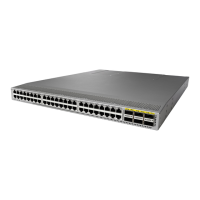Send document comments to nexus3k-docfeedback@cisco.com
12-2
Cisco Nexus 3000 Series NX-OS Unicast Routing Configuration Guide, NX-OS Release 5.0(3)U1(1)
Chapter 12 Configuring HSRP
Information About HSRP
• HSRP Messages, page 12-4
• HSRP Load Sharing, page 12-4
• Object Tracking and HSRP, page 12-5
• Virtualization Support, page 12-5
HSRP Overview
When you use HSRP, you configure the HSRP virtual IP address as the host’s default router (instead of
the IP address of the actual router). The virtual IP address is an IPv4 address that is shared among a group
of routers that run HSRP.
When you configure HSRP on a network segment, you provide a virtual MAC address and a virtual IP
address for the HSRP group. You configure the same virtual address on each HSRP-enabled interface in
the group. You also configure a unique IP address and MAC address on each interface that acts as the
real address. HSRP selects one of these interfaces to be the active router. The active router receives and
routes packets destined for the virtual MAC address of the group.
HSRP detects when the designated active router fails. At that point, a selected standby router assumes
control of the virtual MAC and IP addresses of the HSRP group. HSRP also selects a new standby router
at that time.
HSRP uses a priority mechanism to determine which HSRP-configured interface becomes the default
active router. To configure an interface as the active router, you assign it with a priority that is higher
than the priority of all the other HSRP-configured interfaces in the group. The default priority is 100, so
if you configure just one interface with a higher priority, that interface becomes the default active router.
Interfaces that run HSRP send and receive multicast User Datagram Protocol (UDP)-based hello
messages to detect a failure and to designate active and standby routers. When the active router fails to
send a hello message within a configurable period of time, the standby router with the highest priority
becomes the active router. The transition of packet forwarding functions between the active and standby
router is completely transparent to all hosts on the network.
You can configure multiple HSRP groups on an interface.
Figure 12-1 shows a network configured for HSRP. By sharing a virtual MAC address and a virtual IP
address, two or more interfaces can act as a single virtual router.

